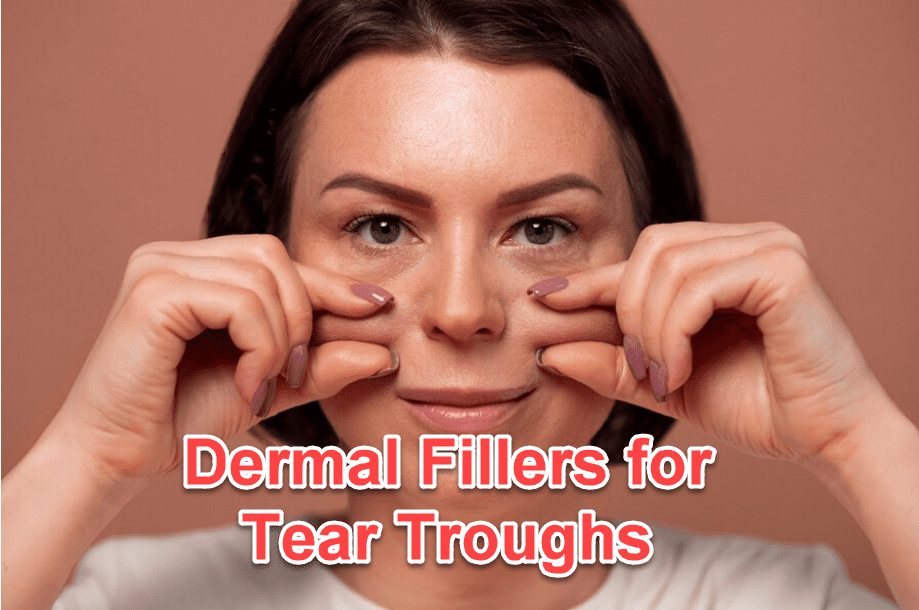Are you tired of constantly being asked if you feel okay because of your dark circles and puffy under-eye bags? Do you find yourself relying on concealer to hide the shadows that make you look older, tired, or sad? If so, you’re not alone.
Many people struggle with the appearance of tear troughs, which various factors, including genetics, aging, and lifestyle habits, can cause. But what if there was a way to effectively diminish the appearance of these pesky under-eye problems without surgery? Enter tear trough fillers—a non-invasive cosmetic treatment gaining popularity recently.
In this blog post, we’ll explore what tear-trough fillers are, how they work, and whether they can truly help you achieve a more refreshed, youthful look. So, grab a cup of coffee (or a cucumber slice for your eyes), and let’s dive in!
What Is a Tear Trough?
A tear trough is a deep crease or hollow that runs from the inner corner of the eye, following the contour of the lower eyelid and extending outward towards the cheek.
It is a natural part of the facial anatomy, but the tear trough can become more pronounced for some people, creating a shadow or dark circle that can make them look tired, older, or even sad.
What Causes Tear Troughs?
Various factors, including genetics, aging, and lifestyle habits, can cause tear troughs.
As we age, we lose volume in our face, particularly in the cheeks and under-eye area, which can cause the tear trough to become more pronounced. This volume loss is due to a decrease in collagen and elastin production and a loss of fat in the area.
Additionally, some people are born with deeper tear troughs due to their facial anatomy. Other factors contributing to the appearance of tear troughs include allergies, lack of sleep, dehydration, and smoking.
What Do Tear Trough Fillers Do?
Tear trough fillers are a cosmetic treatment that involves injecting a soft, gel-like substance, typically hyaluronic acid, into the tear trough area to add volume and smooth out the contours of the under-eye region.
The filler works by plumping up the hollows and creases, which can help diminish the appearance of dark circles and shadows.
Tear trough fillers can also help improve the skin’s overall texture and hydration in the under-eye area, giving it a more refreshed and youthful appearance.
The effects of tear trough fillers are temporary, typically lasting between 6 to 18 months, depending on the type of filler used and the individual’s metabolism.
Can Tear Trough Fillers Effectively Diminish the Appearance of Dark Circles and Puffiness?
Yes, tear trough fillers can be an effective treatment for diminishing the appearance of dark circles and puffiness in the under-eye area.
By adding volume to the tear trough region, the filler can help smooth out the under-eye area’s contours, reducing the appearance of shadows and hollows that can contribute to dark circles.
Additionally, the filler’s hyaluronic acid can help hydrate and plump up the skin, which can further improve the overall appearance of the under-eye area.
However, it is important to note that tear trough fillers may not be suitable for everyone, and the effectiveness of the treatment can vary depending on the individual’s specific concerns and facial anatomy.
A qualified and experienced practitioner can help determine whether tear trough fillers are the best option.
How Do You Get Rid of Tear Troughs?
Depending on the severity of the issue and the individual’s preferences, there are several ways to eliminate or minimize the appearance of tear troughs.
One of the most popular and effective treatments is tear trough filler, which involves injecting a soft, gel-like substance into the tear trough area to add volume and smooth out the contours of the under-eye region.
You can also try topical solutions, like eye creams packed with retinol, vitamin C, and caffeine. These ingredients are great for enhancing the skin’s texture and moisture around your eyes.
Surgical options like blepharoplasty (eyelid surgery) or fat transfer may be recommended in more severe cases. Lifestyle changes, such as getting enough sleep, staying hydrated, and managing allergies, can also help improve tear troughs’ appearance over time.
Why Choose Tear Trough Fillers?
Tear trough fillers are a popular choice for many people looking to improve the appearance of their under-eye area for several reasons.
First, the treatment is very simple and requires no downtime, meaning patients can return to normal activities immediately after the procedure.
Second, tear trough fillers can provide natural-looking results that can help to refresh and rejuvenate the appearance of the under-eye area without looking overdone or artificial.
Thirdly, since tear trough fillers only last about 6 to 18 months, you get the chance to test them out and decide if you’re happy with the look before you think about a longer-lasting fix.
On top of that, these fillers won’t break the bank like surgery might, putting them within reach for more folks.
What Is the Success Rate of Tear Trough Fillers?
Tear trough fillers have a high success rate in improving the appearance of dark circles and hollows under the eyes. Many patients notice a big boost in how the skin under their eyes looks following the treatment.
But, the level of success may shift, contingent on several aspects such as the individual’s anatomy, the severity of the tear troughs, and the skill of the practitioner. On average, around 80-90% of patients are satisfied with their tear trough filler treatment results.
What Is the Most Common Filler for Tear Troughs?
The most common filler used for tear troughs is hyaluronic acid (HA) fillers. HA fillers are popular because they are safe, effective, and reversible. Some of the most commonly used HA fillers for tear troughs include:
These fillers are specifically designed for use in delicate areas like the under-eye region and have a soft, smooth consistency that helps to create natural-looking results. They also have a low risk of complications and side effects and can be easily reversed.
The specific filler you use will depend on your individual needs and preferences, as well as your practitioner’s recommendation.
What Are the Benefits of Tear Trough Fillers?
The benefits of tear trough fillers include:
- Reducing the appearance of dark circles and hollows under the eyes
- Creating a more refreshed and youthful appearance
- Improving the overall contours of the under-eye area
- Boosting confidence and self-esteem
- Providing an alternative to surgery
- Offering temporary results that can be adjusted or reversed if needed
- Requiring minimal downtime and allowing patients to return to normal activities quickly
Are Tear Trough Fillers Safe?
Tear trough fillers are considered safe when performed by a qualified and experienced practitioner.
HA fillers, the preferred option for tear trough enhancements, are known for their low complication and side effect rates. However, like all medical procedures, they come with certain risks, like:
- Bruising and swelling
- Redness and tenderness
- Lumps or bumps under the skin
- Infection
- Allergic reaction to the filler
- Asymmetry or unevenness in the results
- Over-filling or under-filling of the tear troughs
- Migration of the filler to other areas of the face
- Vascular occlusion (blockage of blood vessels)
While these risks are relatively rare, they can occur, especially if an inexperienced or unqualified practitioner performs the treatment.
Who’s the Right Fit for Under-Eye Filler Treatment?
Suitable candidates for under-eye filler include:
- People with deep tear troughs or hollows under the eyes
- Those with dark circles caused by volume loss or shadowing
- Individuals in good overall health
- Non-smokers
- Those with realistic expectations for the results of the treatment
- People who are not pregnant or breastfeeding
- Those who are not allergic to the filler material
- Individuals who do not have active skin infections or inflammation in the treatment area
Who Is Unsuitable for Tear Trough Filler?
Unsuitable candidates for tear trough filler include:
- People with severe bags or excess skin under the eyes
- Those with dark circles caused by skin pigmentation or thin skin
- Those battling active skin infections or puffiness in the targeted area
- Those with a history of keloid scarring
- Persons with bleeding disorders or taking medication to reduce blood clotting.
- Those with a known allergy to the filler material
- Individuals with unrealistic expectations for the results of the treatment
- Pregnant or breastfeeding women
How Do I Know If Tear Trough Fillers Can Treat My Dark Circles?
To determine if tear trough fillers can treat your dark circles, consider the following:
- Are your dark circles caused by volume loss or shadowing rather than skin pigmentation?
- Do you have deep tear troughs or hollows under your eyes?
- Is your skin in the under-eye area relatively thin and free of excess skin or bags?
- Are you in good overall health and free of active skin infections or inflammation?
- Do you have realistic expectations for the results of the treatment?
If you answered yes to these questions, tear trough fillers might be a suitable treatment option for you.
What Does the Tear Trough Procedure Entail, and How Is It Performed?
The tear trough filler procedure typically involves the following steps:
- Consultation: You’ll have a sit-down with your practitioner to talk through your worries, medical background, and the outcomes you’re hoping for.
- Cleansing: The under-eye area will be cleaned and prepped for the injection.
- Numbing: To lessen the sting, a numbing cream might be slathered on before the injection.
- Injection: The filler will be injected into the tear trough area using a fine needle or cannula.
- Massage: The practitioner may gently massage the area to ensure the even filler distribution.
- Ice: Ice may be applied to the area to reduce swelling and bruising.
- The whole process typically wraps up within 30 to 60 minutes.
Does Tear Trough Filler Hurt?
Tear trough filler injections can cause some discomfort, but most patients find the procedure tolerable. Some common sensations during the injection may include:
- Pressure
- Pinching
- Mild stinging or burning
To minimize discomfort, your practitioner may use a topical numbing cream or inject the filler using a fine needle or cannula. After the procedure, you may experience some tenderness, bruising, or swelling in the treated area, but these side effects should subside within a few days to a week.
What to Do After Tear Trough Fillers?
After receiving tear trough fillers, it is important to:
- To cut down on swelling and bruising, put ice on the treated spot for 10 to 15 minutes each go.
- Sleep with your head elevated on a few pillows to minimize swelling
- Don’t fiddle with or rub the treated area for at least a day.
- Hold off on tough exercise, sauna visits, and hot tub soaking for a day or two.
- Avoid alcohol and blood-thinning medications for 24-48 hours
- Gently apply makeup, if desired, after 24 hours
- Pay attention to any more aftercare guidelines your practitioner provides.
What Not to Do After Tear Trough Fillers?
After receiving tear trough fillers, it is important to avoid:
- Let the treated area be, without touching or rubbing it, for at least 24 hours.
- Applying pressure to the treated area, such as sleeping on your face or wearing tight glasses
- Engaging in strenuous exercise, saunas, or hot tubs for 24-48 hours
- Consuming alcohol or blood-thinning medications for 24-48 hours
- Don’t slap on any makeup or skincare products on the treated zone for at least 24 hours.
- Exposing the treated area to excessive sun or heat for 24-48 hours
- Undergoing any facial treatments, such as facials or laser treatments, for at least 2 weeks
What Should I Know About Aftercare and Recovery Time?
The aftercare and downtime for tear trough fillers are quite low-key. You might notice swelling, bruising, and a tender feeling in the treated area immediately after the procedure. These are normal reactions and should diminish within several days to a week.
To ease pain and help with healing, your practitioner will give you clear aftercare directions. These include using ice, sleeping with your head up, steering clear of heavy exercise, and skipping alcohol and some meds.
The majority of patients are able to return to their everyday activities right after their procedure, but it’s vital to follow your practitioner’s guidelines to secure the best results.
How Long Do Tear Trough Fillers Last?
The time tear trough fillers hold up can be different for everyone, affected by the choice of product, personal metabolism, and lifestyle factors.
On average, tear trough fillers last between 12 to 18 months. Hyaluronic acid (HA) fillers, the most commonly used filler for tear troughs, last around 12 months.
After this time, the body naturally breaks down the filler, and the effects gradually diminish. Depending on their needs and preferences, patients may undergo touch-up treatments every 12 months or so to maintain the results.
How Much Does the Procedure Cost?
The cost of tear trough filler treatment can vary depending on several factors, such as the type of filler used, the amount of filler required, the geographical location of the practice, and the experience and qualifications of the practitioner. It is important to remember that the procedure cost should not be the only factor when choosing a practitioner.
Selecting a qualified and experienced provider who prioritizes patient safety and natural-looking results is crucial. Many practices offer financing options or payment plans to help make the treatment more accessible to patients.
Where to Get Tear Trough Treatment in Baltimore
If you want to tear trough filler in Baltimore, then you should call Dr. Lauren Nawrocki at Green Relief Health. She is a highly skilled and experienced medical professional specializing in cosmetic treatments, including tear trough fillers. She is known for her artistry, attention to detail, and dedication to patient safety and satisfaction.
Takeaway
Tear trough fillers are a safe, effective, and non-invasive treatment option for individuals looking to reduce the appearance of dark circles, hollows, and shadows under the eyes.
Using hyaluronic acid (HA) fillers, skilled practitioners like Dr. Lauren Nawrocki at Green Relief Health in Baltimore can help patients achieve natural-looking, long-lasting results with minimal downtime and side effects.
When considering tear trough fillers, choosing a qualified and experienced provider who prioritizes patient safety and satisfaction is essential. Patients should also have realistic expectations for the treatment’s results and be prepared to follow proper aftercare instructions to ensure the best possible outcome.
While the cost of tear trough fillers can vary, the benefits of the treatment, including improved self-confidence and a more refreshed, youthful appearance, can make it a worthwhile investment for many patients.
With touch-up treatments every 12 months or so, patients can maintain their results and enjoy a brighter, more rejuvenated look for years to come.






